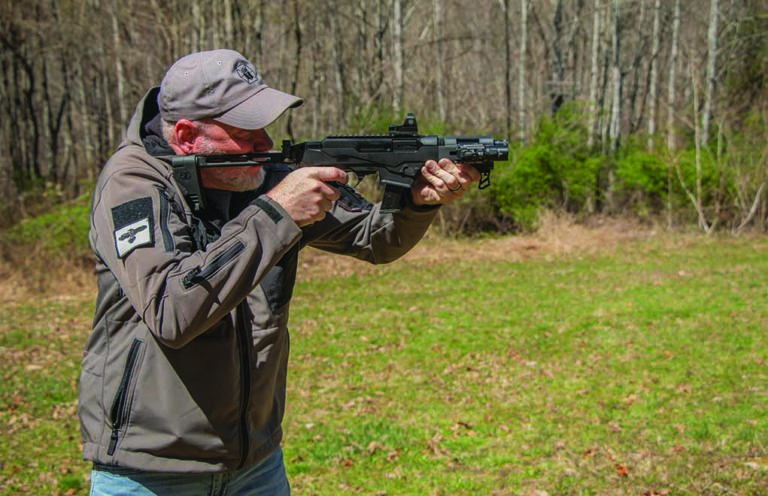
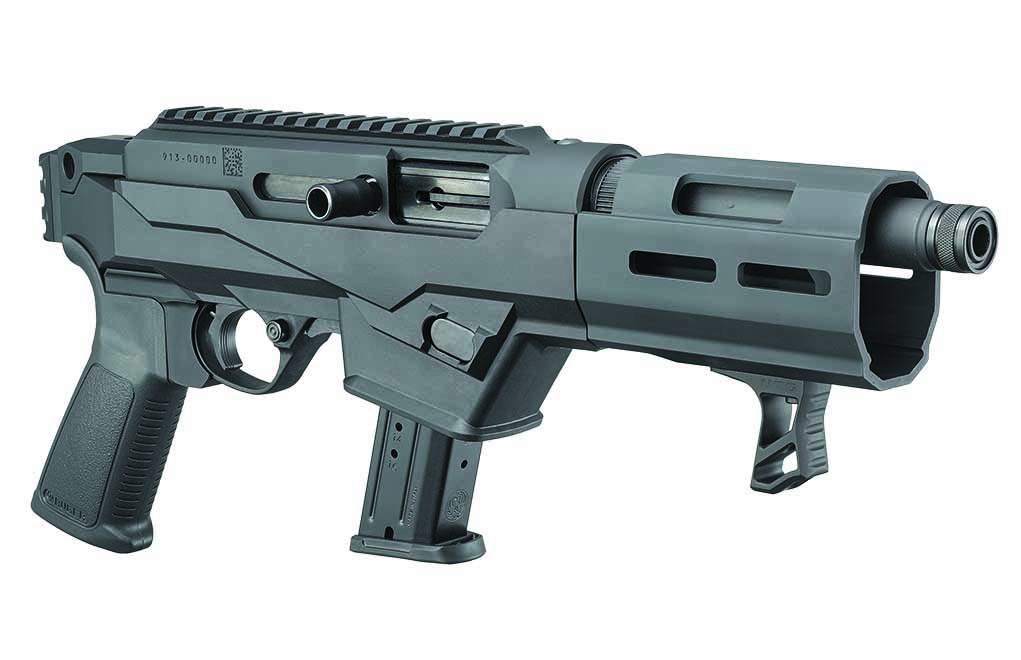
Here Are The Stances And How The PC Charger Shot:
- One-Hand Stance
- Two-Hand Stance
- Two-Hands, Carbine-Style
- One-Hand With Arm Brace
- Hip-Shooting
- Hip-Shooting With Laser Sight
- Strap-Resistance
- Shoulder
- Arm Brace To Cheek
- Arm Brace To Chest
Using the Ruger PC Charger as the test firearm, we analyze various techniques and accessories that work best with it, AR pistols and other pint-sized heaters.
Have you ever wondered about the legalities surrounding, or the best techniques for shooting, one of those hybrid pistols/AR pistols that look like a rifle with its buttstock and barrel chopped off? If so, maybe this will help.
The Confusion
Ruger’s new PC Charger is, by definition, a pistol. The “PC” stands for “pistol caliber,” which is a bit confusing: There’s really no such thing as “pistol caliber.” “Caliber” refers to the diameter of a bullet; what PC should stand for is “pistol cartridge.” But then, why would a pistol be referenced as being “pistol caliber” or “pistol cartridge?”
Well, this comes from rifles that fire pistol cartridges, which are often referred to as “pistol-caliber carbines.” Ruger offers the PC Carbine, a rifle that fires cartridges commonly chambered in pistols. “Charger” is the term Ruger uses to describe its pistols that are based on rifles; Ruger’s 22 Charger is based on the Ruger 10/22.
If you’re not confused yet, keep reading.
With these pistols—hybrid pistols, if you will—there’s some confusion about how you can actually—legally—shoot them, particularly if they’re equipped with an arm brace. An arm brace is an extension to the rear of a pistol that resembles a buttstock. In actuality, it’s there for the purpose of strapping a pistol—a pistol that’s really too damned big to be shot with one hand anyway—to your arm.
Of course, once attached, it can serve as a makeshift buttstock if you’d like to shoulder the weapon. But does that then make the pistol a short-barreled rifle (SBR)? If so, it then becomes an NFA (National Firearms Act) firearm, which is highly taxed and regulated.
Initially, in 2014, it was OK to put an arm brace on a pistol and shoot it from any position you liked. But, in 2015, the ATF ruled that firing a pistol with an arm brace from your shoulder effectively made the pistol an SBR, required the filing of ATF form 1 … along with the payment of the requisite tax. This, of course, was asinine; how you decide to hold a weapon should have no impact on its classification or the taxes you pay.
Huh??
But that wasn’t the end of it.
In 2019, the ATF revised its position as follows: “To the extent the January 2015 Open Letter implied or has been construed to hold that incidental, sporadic, or situational ‘use’ of an arm-brace (in its original approved configuration) equipped firearm from a firing position at or near the shoulder was sufficient to constitute a ‘redesign,’ such interpretations are incorrect and not consistent with ATF’s interpretation of the statute or the manner in which it has historically been enforced.”
What does that mean? Well, it would appear that you can shoot an arm brace-equipped pistol from any position you choose, but if you shoot it “from a firing position at or near the shoulder,” it can only be done “incidentally, sporadically, or situationally.” This appears to mean you can only do it at irregular intervals or only in limited situations.
Are you still confused? I am. Because of this “ruling,” the conventional wisdom seems to be that you can do it sometimes, but you shouldn’t show it off. (I guess it’s OK to act within the law, as long as you don’t brag about it.)
I know this is a nuisance of minutiae to digest just so you can shoot your pistol. However, it’s extremely important that, as legal gun owners, we don’t break the law—no matter how confusing the law might be. All of this muddlement about how you can legally shoot a pistol with an arm brace got me to wondering about something that’s more important from a practical standpoint. And that’s what’s best or the most effective way to shoot one of these guns.
Ten Tests, Ten Results
I figured I’d find out for myself. I took Ruger’s new PC Charger and fired a string of 10 shots as fast as I thought I could make good hits on a common B27 target at 10 yards from 10 different positions. I timed and scored the results to facilitate a comparison; hits in the X, 10 and 9 rings counted for 10 points; everything else was listed at 0 points. The total of all hits was then divided by the total time, as you would with Comstock, Virginia-count scoring (that is, the larger the final score, the better). The results surprised me, and I suspect they’ll surprise you as well.
I thought the best way to illustrate the information was with a brief discussion of each test/technique.
Baseline Test

Common pistol, two-hand stance (open sights)
First, I wanted to establish how shooting an arm-braced pistol from various positions compared with shooting a common pistol using a two-hand stance. To do this, I fired 10 shots from 10 yards with my Wilson Combat EDC X9 using a two-hand stance and open sights. I scored 90 points, and it took 4.91 seconds for a final score of 18.33.
Technique 1
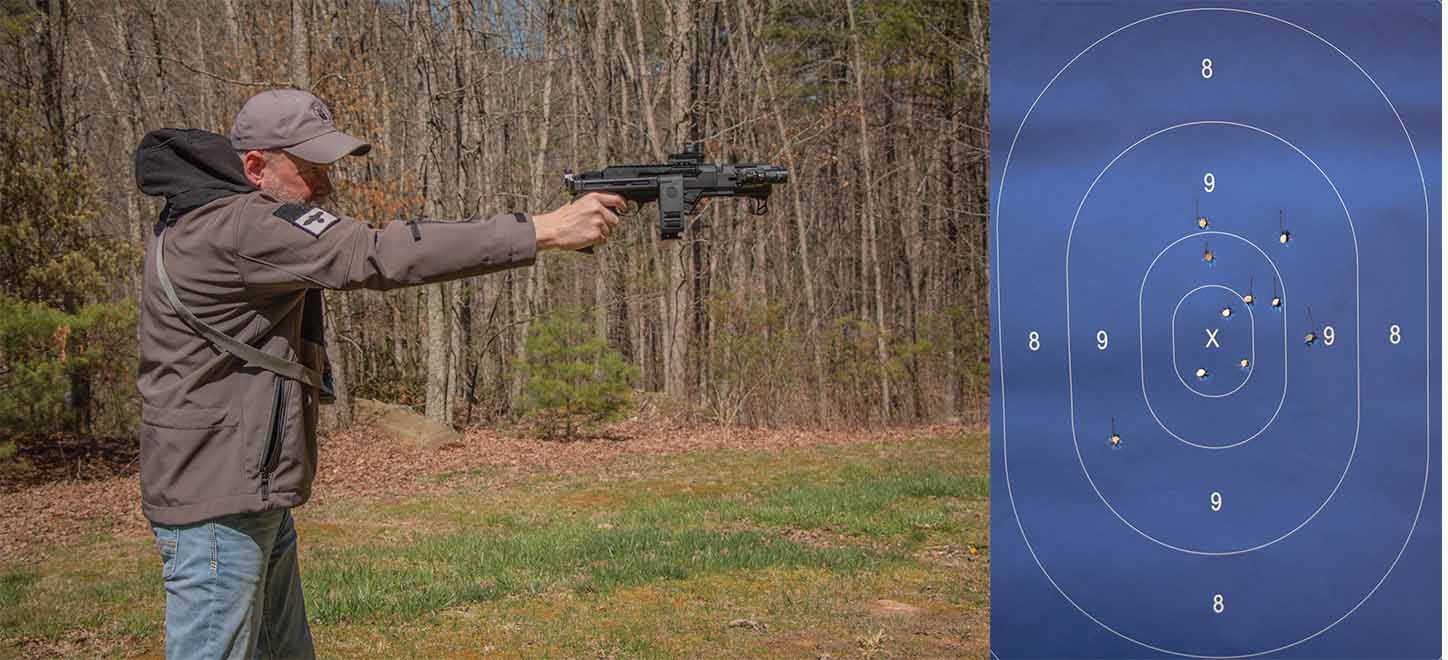
PC Charger, one-hand stance (Crimson Trace CTS 1400 reflex sight)
I didn’t expect a lot from this test. After all, trying to fire a 6.5-pound handgun with one hand shouldn’t produce great results. Accuracy-wise, however, with six 10-zone and four 9-zone hits for 100 points, I didn’t do too badly. But it took 10.8 seconds to get those hits for a score of 9.26. This is a stupid way to shoot this pistol unless you’re trying to show off or it’s the only option you have, given the circumstance. It makes the idea of an arm brace seem magical.
Technique 2

PC Charger, two-hand stance (Crimson Trace CTS 1400 reflex sight)
In this test, the PC Charger was fired with two hands on the pistol grip. I logged 100 points, but it took 11.1 seconds for a score of 9.01, making this method about half as effective as shooting a common handgun in the same manner. The recoil of a 9mm Luger in a 6.5-pound gun is nominal but, given the heavy gun, it was slow to get back on target for follow-up shots.
Technique 3
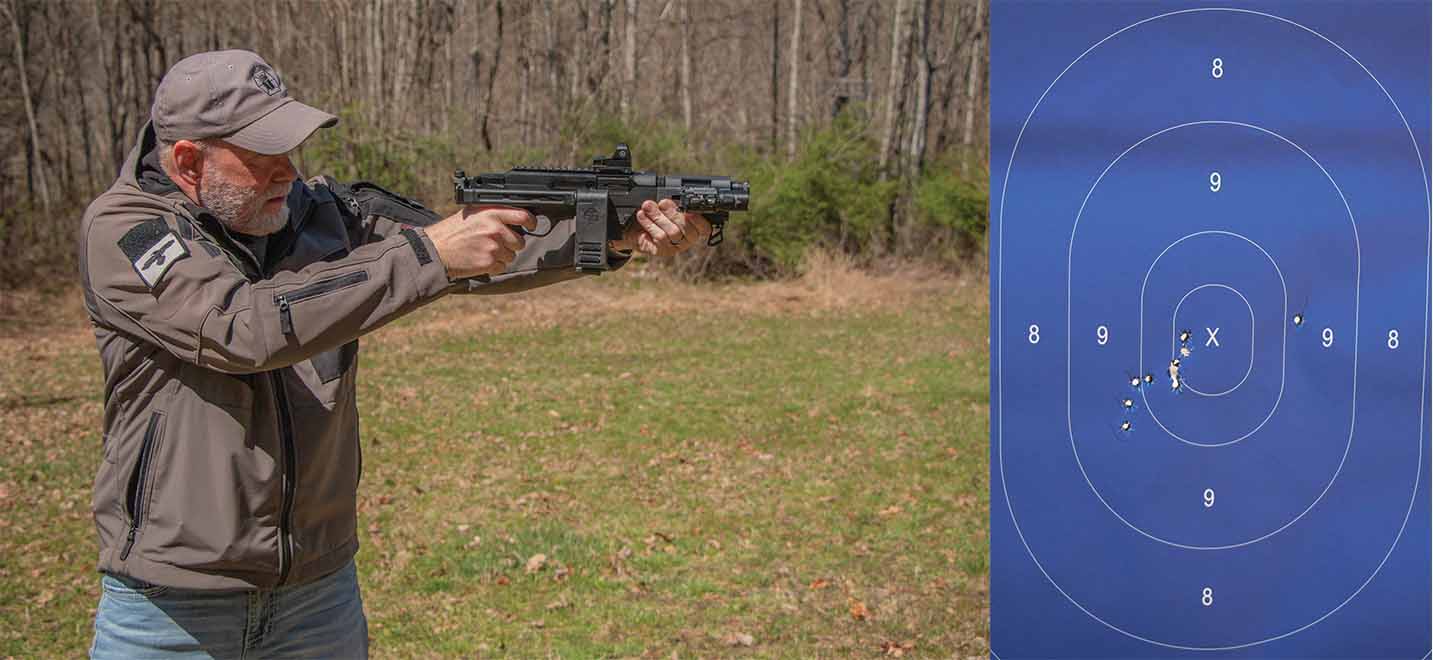
PC Charger, two-hands, carbine-style (Crimson Trace CTS 1400 reflex sight)
This was similar to Test 1, except that I held the PC Charger at the pistol grip with my shooting hand and on the forearm—behind the hand-stop—with my support hand, as you might fire a sawed-off shotgun. The point count was 100, and the time was 9.02 seconds. Everything that applies in Test 2 applies here, with the additional note that the hand-stop on the forearm of the PC Charger was very uncomfortable during recoil. That said, it’s a damned good idea it’s there, because it keeps your support hand from inadvertently moving forward in front of the muzzle.
Technique 4
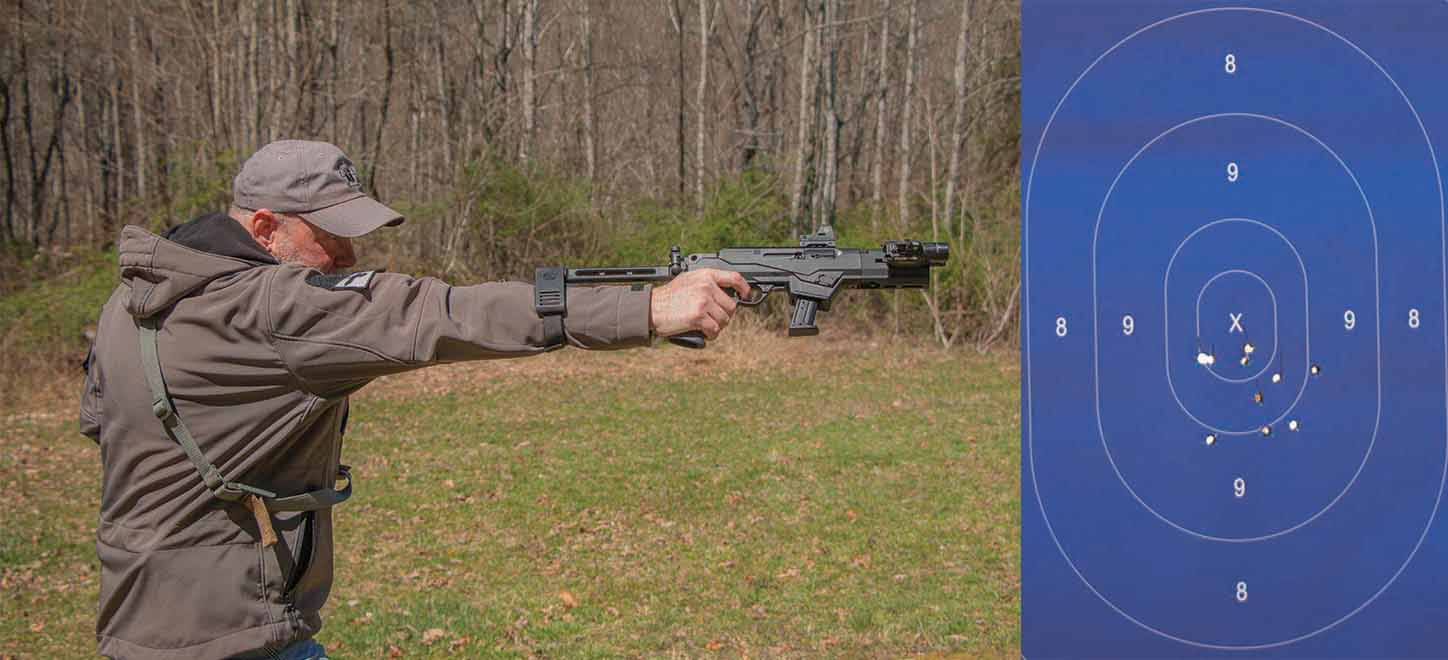
PC Charger, one-hand with arm brace (Crimson Trace CTS 1400 reflex sight)
I was excited to try out the “magical” arm brace that’s caused all the confusion. I secured the very well-made and folding Sig Sauer PCB Kit for its MPX/MCX to the PC Charger. It attached to the Picatinny end rail with a single screw. Holding the pistol with one hand and with the arm brace strapped on the shooting arm, I again managed 100 points—but it took 11.43 seconds for a final score of 8.75. It was the slowest of any method tested. This was uncomfortable, slow and unwieldy. Sure, I’d suggest you try it, if for no other reason than that you could then agree with me that it’s ridiculous.
Technique 5
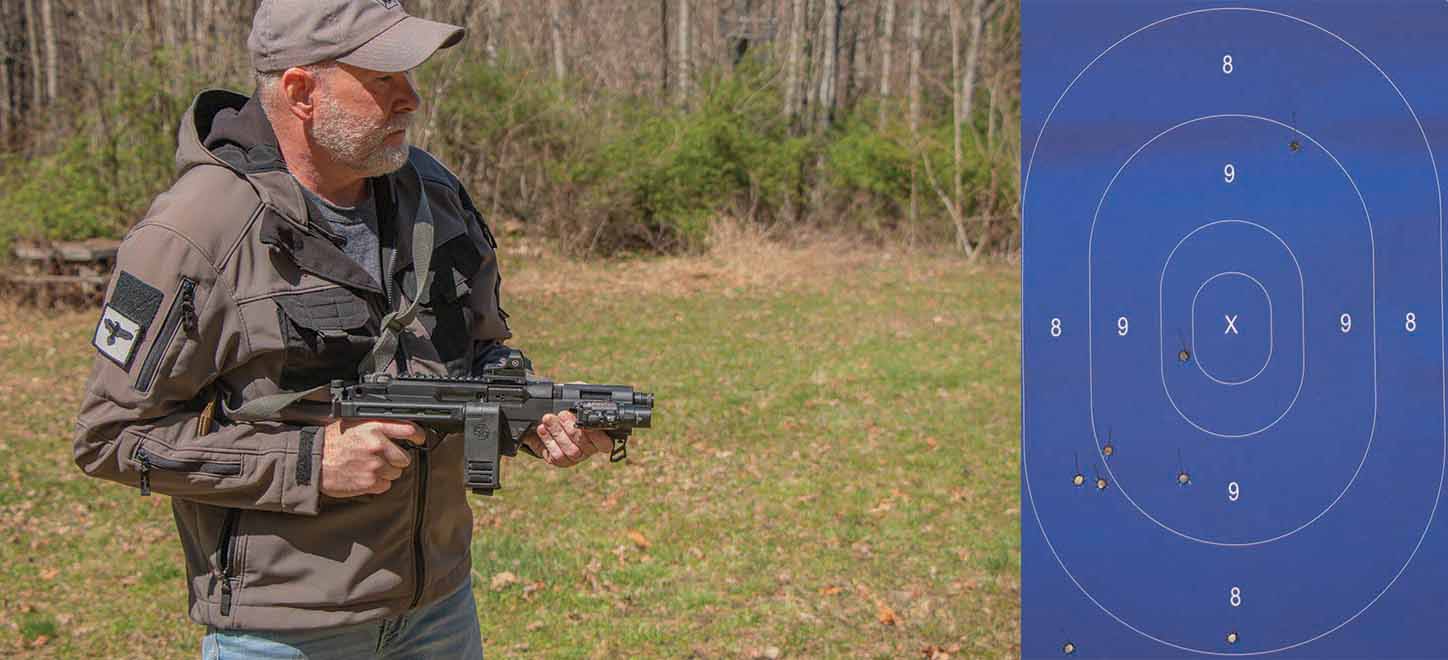
PC Charger, hip-shooting (no aiming device)
Mostly for entertainment purposes, this test involved shooting the PC Charger from the hip without the aid of an aiming device. This was my “Hollywood” test, and with it, I only scored 40 points. However, all 10 shots were fired in only 3.96 seconds for a final score of 10.10. Just as a side note: One shot missed the entire target. With practice, you might get a bit better at this technique, but it’s doubtful you’ll ever be good enough to trust it to save your life or to not shoot things you don’t intend to shoot.
Technique 6
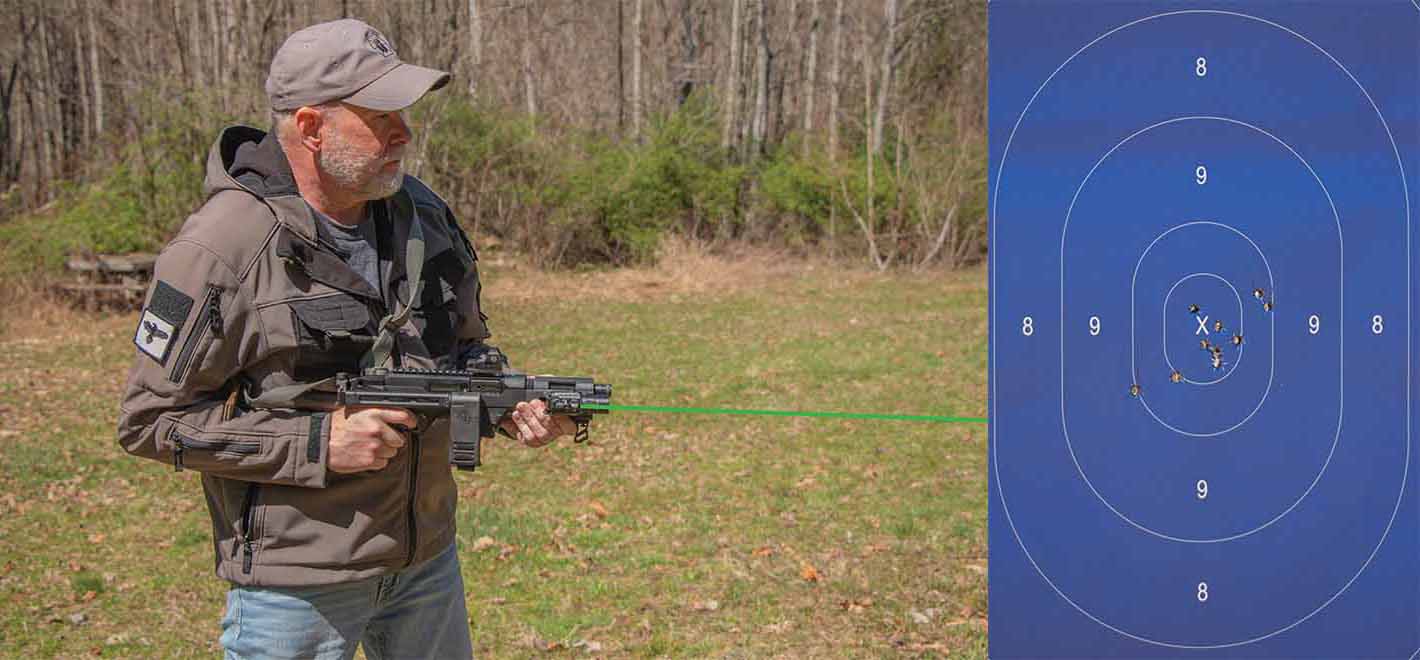
PC Charger, hip-shooting (laser)
I then installed a Surefire X400 light-and-laser combo and fired another 10 shots from the hip while aiming with the laser. This is where the PC Charger began to shine and perform better than a common pistol. I scored 100 points in 5.33 seconds for a final score of 18.76. This might be the best way to utilize the PC Charger. It’s fast, keeps the gun close to your body for retention purposes, is comfortable and would work well in close quarters. Lasers work!
Technique 7
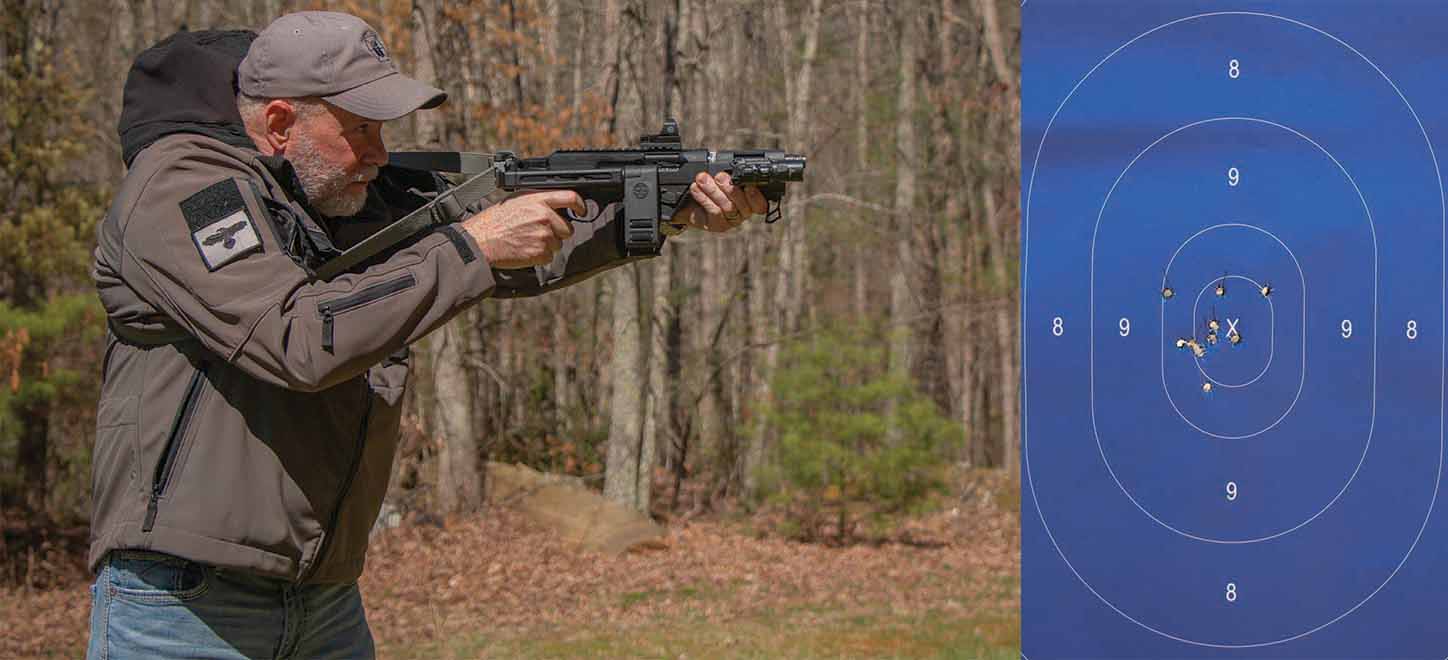
PC Charger, strap-resistance (Crimson Trace CTS 1400 reflex sight)
One of the most common methods for shooting a pistol of similar design to the PC Charger is to use a strap and force the pistol out in front of your body while holding it at the grip and forearm, using the strap as resistance. Doing so while using the Crimson Trace reflex sight, I managed 100 points in 7.62 seconds for a final score of 13.12. Not bad … but not nearly as effective as a common pistol with a two-hand stance. Of course, practice will undoubtedly improve performance, and a strap is a good idea on a gun that weighs almost 7 pounds.
Technique 8
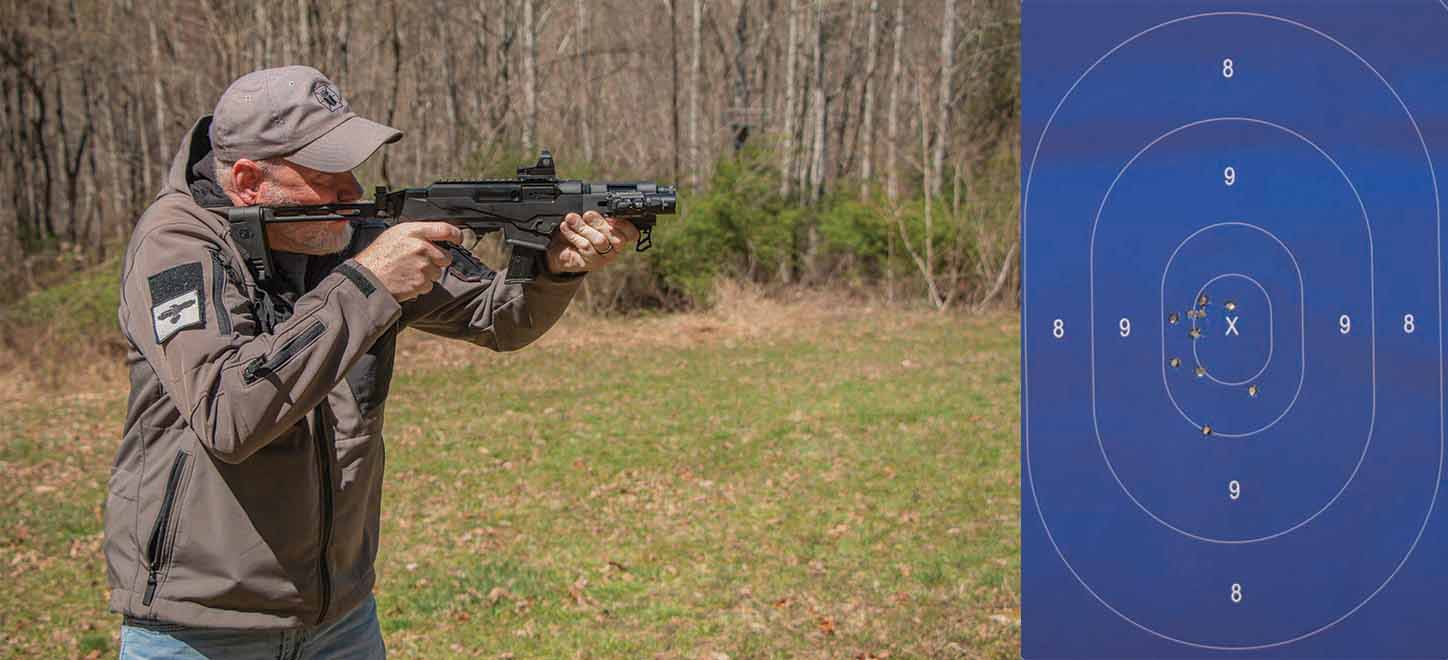
PC Charger, shoulder (Crimson Trace CTS 1400 reflex sight)
Having shot the PC Charger employing several methods, I figured it was now “incidentally, sporadically, or [and] situationally” legal to shoot it by placing the arm brace against my shoulder. I did so using the Crimson Trace reflex sight and logged 100 points in 5.58 seconds for a score of 17.92. This was the third best score the PC Charge managed, and it was very much like shooting an AR-15—but one with an uncomfortable and low cheek weld, which probably explains the slower-than-you-would-expect engagement time.
Technique 9
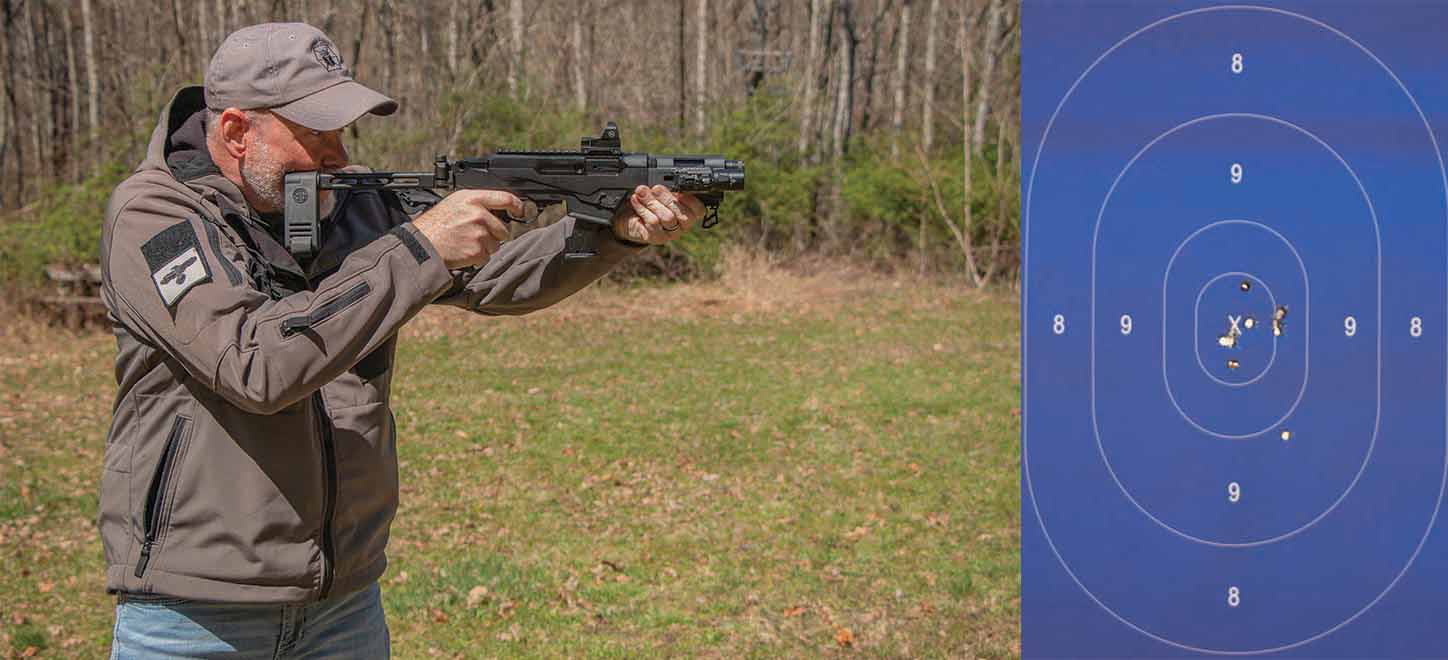
PC Charger, arm brace to cheek (Crimson Trace CTS 1400 reflex sight)
In an effort to avoid violating the 2015 ATF ruling, some shooters began placing the butt of the arm brace against their cheek or chin when shooting these hybrid-type pistols. I tried this and found it uncomfortable. Nevertheless, I did achieve 100 points in 7.45 seconds for a score of 13.42. Here’s the thing: If I were using one of these hybrid pistols to defend my life, I’d just forget this technique and put the damned thing against my shoulder. I’d worry about potential ATF violations—if I managed to survive the gunfight.
Technique 10
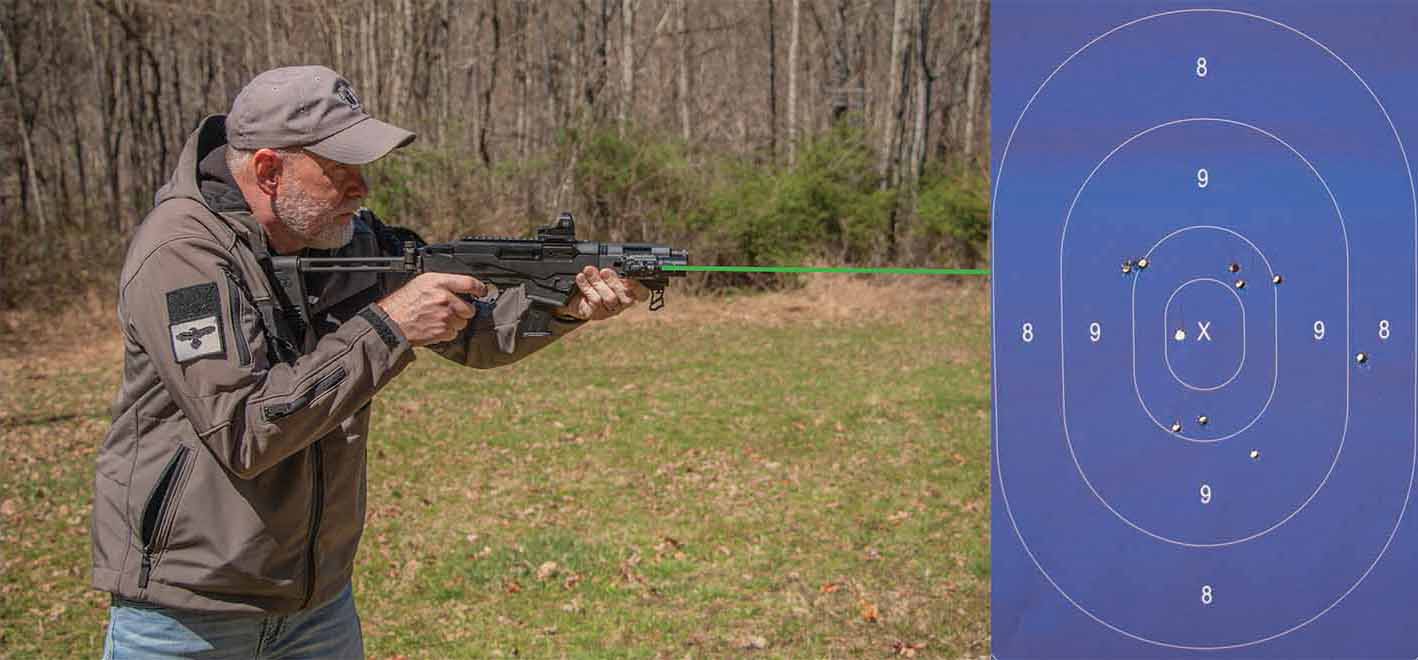
PC Charger, arm brace to chest (laser)
The final test—and this was mostly conducted for the purpose of giving me 10 tests to evaluate—was shooting the PC Charger with the arm brace resting on the center of my chest while using the Surefire X400 laser to aim. In 3.66 seconds, I poked six holes in the 10-ring, three in the 9-ring and one in the 8-ring for a total of 90 points and a score of 24.59. It was, without question, the fastest and most effective method of shooting the PC Charger. Unless you have a very short neck or oddly shaped chest, it’ll place an optical sight too low to see through; but with the laser, it’s an extremely effective and highly controllable technique.

For more information on the PC Charger, please visit ruger.com.
Editor's Note: This article originally appeared in the June 2020 issue of Gun Digest the Magazine.
Get More Ruger Info:
- Great Ruger Guns
- Best Ruger .22 Handguns
- Ruger LCRx .357 Magnum
- Ruger No. 1
- Ruger Precision Rifle
- Ruger Redhawk
- Ruger Super Redhawk
- Ruger Blackhawk
- Ruger Single Six
- Ruger 10/22
- Ruger LCR
- Ruger 77/22
- Ruger 77/44
- Ruger SR1911
- Ruger Hawkeye
- Ruger Mark IV
- Ruger SR-556
- Ruger LCP II
- Ruger American Magnum
- Ruger American Rifle
- Ruger Gunsite Scout Rifle
- Ruger SR-762
- Ruger Red Label
- Ruger SR40
- Ruger Single Nine
- Ruger Bisley
- Ruger Red Label
- Ruger P345
- Ruger 57
- PC Carbine Chassis

Next Step: Get your FREE Printable Target Pack
Enhance your shooting precision with our 62 MOA Targets, perfect for rifles and handguns. Crafted in collaboration with Storm Tactical for accuracy and versatility.
Subscribe to the Gun Digest email newsletter and get your downloadable target pack sent straight to your inbox. Stay updated with the latest firearms info in the industry.

![Best Concealed Carry Guns In 2025 [Field Tested] Wilson Combat EDC X9S 1](https://gundigest.com/wp-content/uploads/Wilson-Combat-EDC-X9S-1-324x160.jpg)


![Best 9mm Carbine: Affordable PCCs [Tested] Ruger Carbine Shooting](https://gundigest.com/wp-content/uploads/Ruger-Carbine-Shooting-100x70.jpg)
![Best AR-15: Top Options Available Today [Field Tested] Harrington and Richardson PSA XM177E2 feature](https://gundigest.com/wp-content/uploads/Harrington-and-Richardson-PSA-XM177E2-feature-100x70.jpg)

What strap did you use for the strap-resistance position?